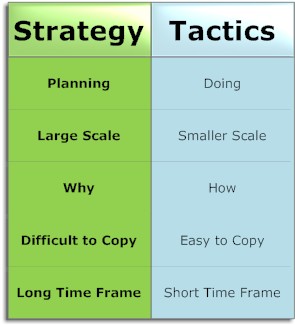“What’s the difference between strategy and tactics, then?” I was asked recently; but of course if you don’t already know it’s a bit like the chicken and the egg.
So let’s get this clear,– strategy always comes before tactics, because strategy is concerned with outcomes and tactics is about means.
Strategy is the destination and tactics is the journey.
It’s a bit like the ‘leader or manager’ debate – strategy is ‘doing the right thing’ while tactics is ‘doing the thing right!’
Without a strong clear strategic aim, tactics are meaningless, or at worse will be designed to achieve the wrong aim.
As that doyen of military practice Sun Tzu said, “Strategy without tactics is the slowest route to victory. Tactics without strategy is the noise before defeat.”
So, unless you have clear knowledge of what needs to be achieved, the destination of the action if you like; even if you have some idea of what actions to take to achieve it, your progress will at best be slow and at worst, completely off target.
It also follows that even carefully planned actions which have little reference to the desired outcome will ultimately fail to achieve it.
Place that into today’s context and I am sure we can find some examples of Sun Tzu’s dictum – where tactics have been spectacularly undertaken, but have failed to address what is claimed to be the strategical aims – in both politics and business.
Sun Tzu also said “All men can see these tactics whereby I conquer, but what none can see is the strategy out of which victory is evolved” which seems to imply that the leader should keep his strategy to himself.
However, as any military leader knows (and business leaders should know – and political leaders – well who knows?) the intention is not to withhold the strategy from your own troops but to disguise it from the enemy.
Clear communication to the people who will be designing the tactics is absolutely necessary, without that whatever tactics are adopted will eventually be futile. How do I know what train to catch if I have no idea of the required destination? Strategy is the destination, tactics is the journey.
Which means of course, that once a strategy has been decided upon, it must be able to be clearly communicated, and that is not a simple as it seems. In fact more disasters have come from misunderstanding the strategy than from executing the tactics.
And then there is the temptation by those that design the strategy to interfere with the tactical achievement of them. Politicians are good at this, after all war is an outcome of politics as Karl Von Clausewitz well knew: “The political object is the goal, war is the means of reaching it”
No-one suffered from detailed political interference more than the Duke of Wellington. The British Government’s strategy was to defeat Napoleon through war in the Peninsula, forcing him to withdraw his troops from Spain & Portugal thereby loosing the southern sea access. It was rather more detailed than that, but it gives the general idea.
But the political masters back in Westminster were determined that Wellington should not be allowed free reign, and bombarded him every day with memos, orders and demands. Luckily, Wellington was made of sterner stuff and wrote back:
My Lord, If I attempted to answer the mass of futile correspondence which surrounds me, I should be debarred from the serious business of campaigning… To the Secretary of State for War during the Peninsular Campaign
It sort of signifies the type of leader that Wellesley was, certainly his ‘Publish and be damned’ response to blackmail was in character.
So what has all this to do with business you may ask?
The person who asked me the original question had recently returned from a business leadership seminar where much time was given to discussing “Strategy”. He felt they had not differentiated between the two, and that this confusion was at the heart of some of the problems facing us today.
Without a strategy you cannot articulate your vision – the desired end result. It is the leader’s role to create this strategic vision – it’s what they are being paid for. It’s the Where we will be and the What we will be doing.
It is also the leader’s role to clearly articulate that strategic vision in concrete terms, not abstract constructs; those that are expected to plan the tactics, the How to get the company there, need to know exactly what it looks like when they have arrived.
And finally, when strategy has been decided and communication is over, the leader needs to step back and not to interfere with the detailed implementation of the tactics. It is the commander on the ground that can see what is before him, it is probably they that have far more up-to-date information which allows them to make the adjustments that lead to victory.
Opportunities multiply as they are seized – Sun Tzu
There is a difference between Strategy and Tactics, and sometimes even the military can get that wrong; but when we have the differences clear in our minds we can create magnificent victories.
Thus it is that in war the victorious strategist only seeks battle after the victory has been won, whereas he who is destined to defeat first fights and afterwards looks for victory – Sun Tzu
Michele @ Trischel



